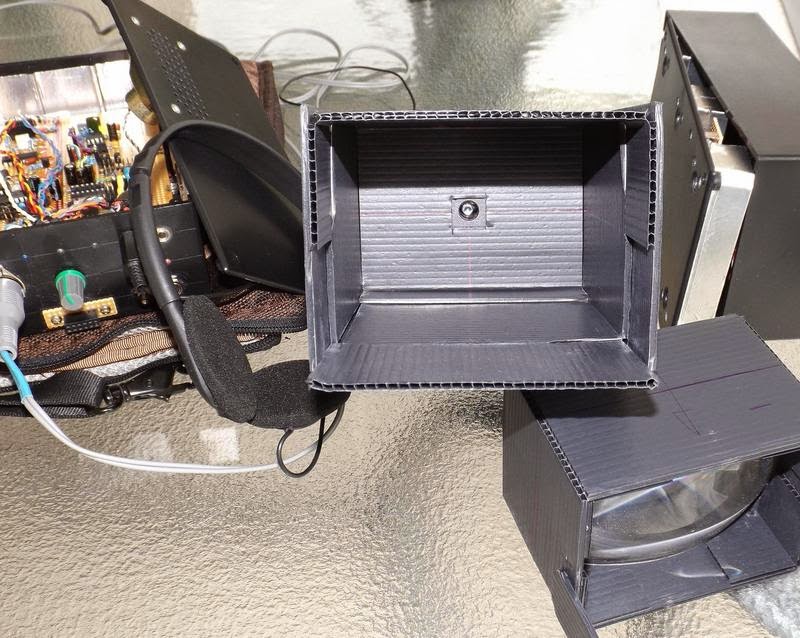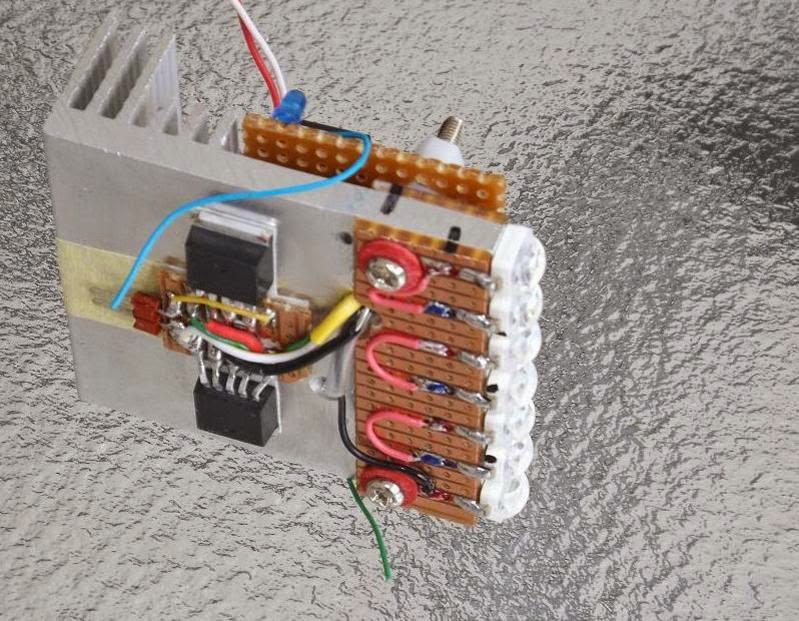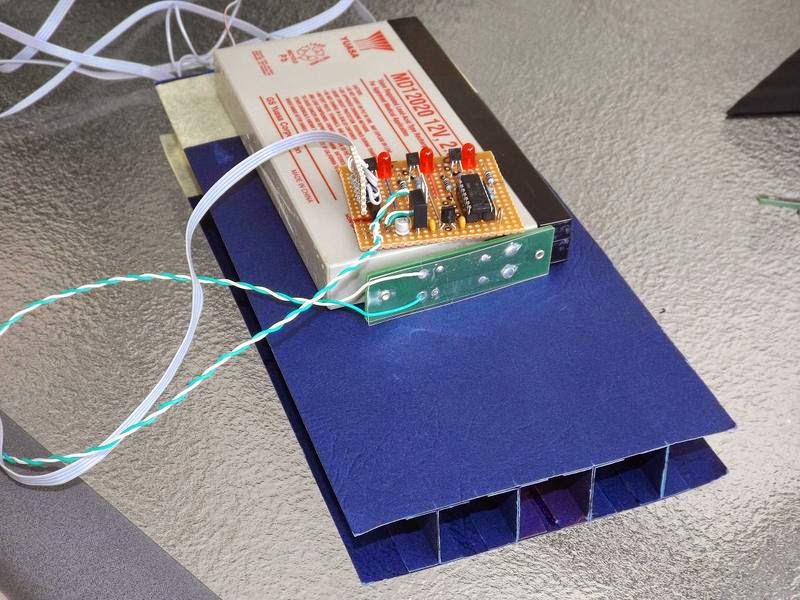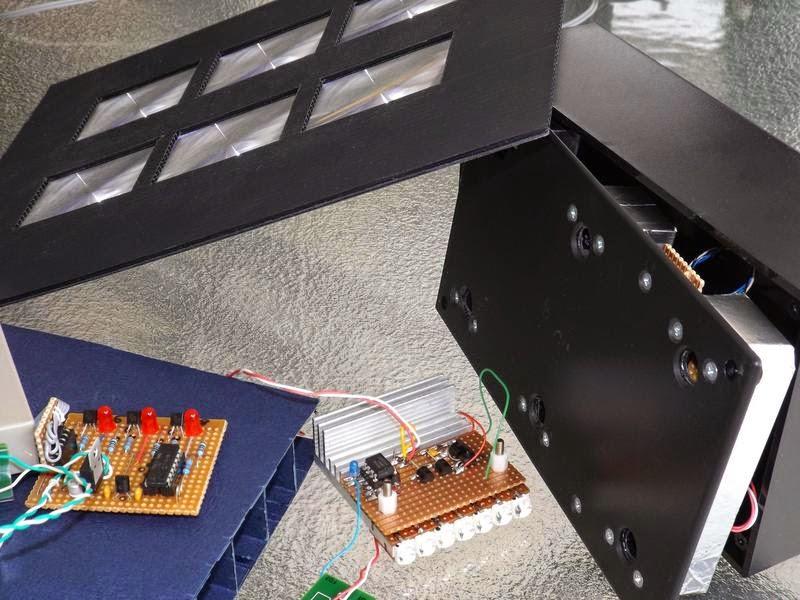 What I’ve been playing with over Christmas and New Year (anyone want a nice FT1000MP?)
What I’ve been playing with over Christmas and New Year (anyone want a nice FT1000MP?)
With my return to work on the horizon on Monday, I’ve been thinking about what a nice holiday I’ve had. Although I’ve had to do a bit of work here and there, it’s not been too onerous which has been welcome.
I’ve not done anything exceptionally different this holiday, but it’s been nice varied activity. There have been a couple of sessions when I bounced my 144MHz packet signals through the digipeater on the International Space Station. That’s always satisfying and nice to do – particularly with a very simple aerial.
I missed the ISS’ SSTV operations but all of that made me think about operating SSTV a little and it’s been fun to play with and I’ve had 2 or 3 nice ‘QSOs’ or picture exchanges with many other pictures being seen.
Tim Kirby, G4VXE, is a regular contributor to AmateurRadio.com and writes from Oxfordshire, England. Contact him at [email protected].
 Marketing With Morse Code
Marketing With Morse Code
Code-is-not-dead prognosticators and hand-wringers will be happy to hear Asus is touting a new smartphone camera feature with Morse code. The smartphone feature has something to do with dual cameras and exceptional zoom capability but unfortunately appears to have no use of Morse code. But a tip of the hat to Asus marketing folks for using code!
Anthony, K3NG, is a regular contributor to AmateurRadio.com.
 New Year’s Eve Magic
New Year’s Eve Magic
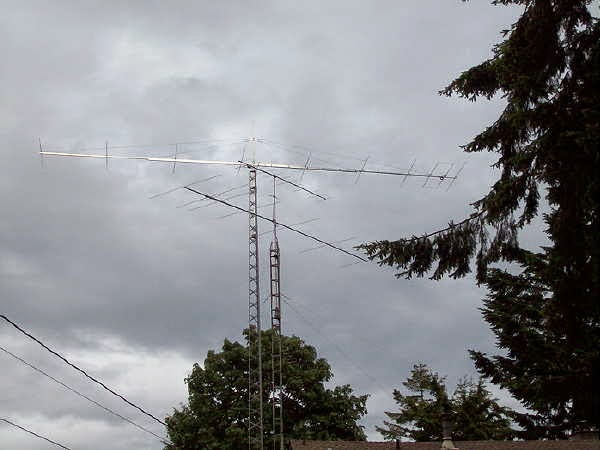 |
| 9el LFA at VE7DAY |
During the last solar rotation, flux values rose to near-Cycle highs and quickly plummeted, along with any hope of finding that six-meter Holy Grail...long-haul F2 propagation. Many six meter ops quickly found other things to do.
One person that didn't stop watching, and never does, was John - VE7DAY, in Campbell River, B.C., on Vancouver Island. John is VE7's iron man of 6m and spends almost 100% of his radio time seeking the magic.
For the past few winters, John has pointed his beam towards the south Pacific at around sunset, and called CQ from the VE7 black hole....on Tuesday evening he was justly rewarded.
At 00:50 UTC on the 31st, John's CQ was answered by Roger, ZL3RC in Christchurch, on New Zealand's South Island...12,021km from Campbell River.
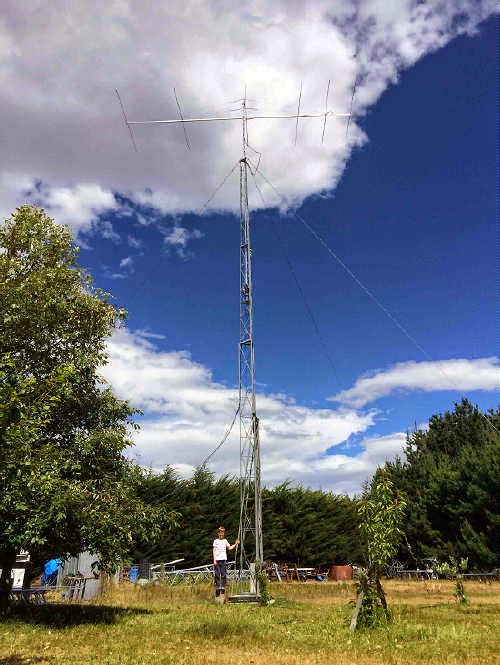 |
| 6el Yagi at ZL3RC |
One minute later, John worked Chris, ZL2DX, in Martinborough, on the North Island.
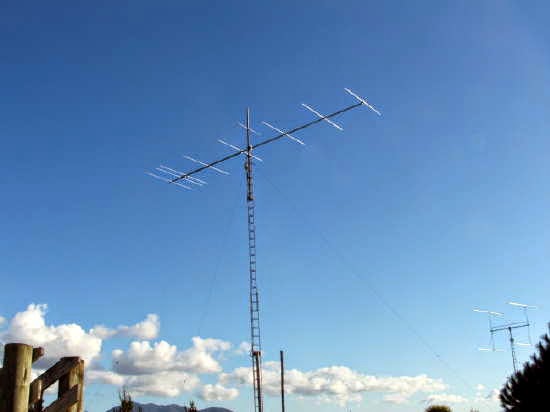 |
| 8el Yagi at ZL2DX |
At 0111 UTC, John completed the hat-trick by working Paul, ZL4PW, in Oamaru, back on the South Island.
 |
| Paul, ZL4PW / 7el at 7m |
"Decades ago, many DXers believed that Argentina was the world DX hot spot. DXers and contesters seemed to do the best down there. When I was in Brazil, one of the places I lived in was the state of Mato Grosso do Sul, PT9-land. It was only about an hour-and-a-half's drive to the Paraguay border, so conditions there were pretty near like those in Argentina, which was also nearby. I ran 100 watts to a vertical wire taped to a bamboo rod... and thought my QTH must have been included in the hot spot area.
I think now we are becoming aware of another hot spot, this one being in North America on Vancouver Island. I'm speaking, of course, of the your QTH, John! You seem to be doing quite well from that location. Keep it up!!
I see you worked clear down to ZL4. I'm envious. I've been looking for a ZL4 contact for a long time. Today when the band was open to ZL, I was on the road returning from Tacoma. Well, I'm glad you were able to work that great DX.
I will change the Distance Scoreboard to indicate the new records you established today. Congrats!
73, Paul K7CW"
With the present dismal solar flux and low solar activity, it is not likely that these contacts were via the F2 mode, but you wouldn't know it from the size of John's signal, recorded by ZL3RC. Being in the middle of our secondary sporadic-E season, north of the equator and at the peak of the major Es season down-under, I think a better candidate is an Es-link from both sides into the Trans Equatorial afternoon 'bubble'....certainly Es from both ends into whatever is happening in the ionospheric cauldron at the equator!
All four stations were running high power and big antennas, and with a little help from the seasonal E, it all seems to have come together nicely.

Congrats to all involved, and especially John, as all of the other 6m ops in this part of the country, including myself, were asleep at the switch it seems!
Steve McDonald, VE7SL, is a regular contributor to AmateurRadio.com and writes from British Columbia, Canada. Contact him at [email protected].
 New Year’s Day 2015
New Year’s Day 2015
I participated in the QRP ARCI New Year's Day Sprint as planned, but was disappointed in the lack of activity. I guess everyone was sleeping off a night of merry-making and partying. In the 2 & 1/2 hours that I was on the air, I made only over just a dozen QRP ARCI contacts. It's a good thing that it's SKN, as the bands were busy and I was able to fill in with a couple rag chews in between to keep me from falling asleep at the key.
15 Meters seemed to be the good band for the Sprint. It was less noisy than 20 Meters, and it seemed that it was there that I was hearing the most activity. Towards the end of the Sprint, 40 Meters perked up with some local QRP activity.
After dinner, I came down to participate in a little more SKN, garnering a few rag chews using my refurbished Vibroplex Original.
I was pleasantly surprised that for not having used it in a while, that my fist wasn't all that bad! I cleaned the contacts by rubbing them using a spare QSL card and re-adjusted the spacing and tension. Pretty soon I was sounding almost as good as my keyer and paddles. Notice I said almost, not quite as good as that but not horrid, either. I guess using a bug is like riding a bicycle - once you become comfortable at it, you never forget how.
I finished up the evening by tuning across 30 Meters to hear 1A0C from the Sovereign Order of Malta (Thanks for the clarification, Karl DK5LP) running a pileup. It was a pretty good pileup but he was quite strong - about 579 and getting stronger. I stayed with him for about a 1/2 hour, trying with 5 Watts. As this is a special one for me, I ended up turning up the juice to 85 Watts and nabbed him on my third attempt after that. The DXpedition is there for about five more days, so I will try again over the weekend using QRP - if I hear them.
The Sovereign Order of Malta is a charitable arm of the Catholic Church. They have been in existence since around 1050 and are dedicated to helping the sick and poor throughout the world. Recently, Raymond Cardinal Burke was named patron of the Sovereign Military Order of Malta, a man whom I admire greatly. It was a special treat to have worked them.
So Amateur Radio-wise, 2015 is off to a flying start. I hope it keeps going that way all year long! Let's see if I can work both Foxes in the 80 Meter Fox hunt tonight. ( I did. Yay! )
72 de Larry W2LJ
QRP - When you care to send the very least!
Larry Makoski, W2LJ, is a regular contributor to AmateurRadio.com and writes from New Jersey, USA. Contact him at [email protected].
 Happy New Year to all
Happy New Year to all
Mike Weir, VE9KK, is a regular contributor to AmateurRadio.com and writes from New Brunswick, Canada. Contact him at [email protected].
 SPECIAL MESSAGE FROM BILL PASTERNAK WA6ITF
SPECIAL MESSAGE FROM BILL PASTERNAK WA6ITF
Hi All,
This is Bill direct from my hospital bed here in Los Angeles. As some of you many already know, I was involved in a household accident and am now in the initial recovery phase.
I do not know how long I will be here but I suspect it will be another week or two. During that time it will be hard to produce the weekly Newsline bulletins but we will resume operations as soon as feasible. But for now its just rest, take my medicines and recover.
My thanks to all for your good wishes and a very Happy New Years 2015 to all. Ill try to post here as time nd health permits. In the meantime you can find late ham radio news posted by our moderators on our Amateur Radio Newsline page on Facebook
73
Bill Pasternak, WA6ITF
 VK4EBP’s NLOS Lightwave Experiments – Part 3
VK4EBP’s NLOS Lightwave Experiments – Part 3
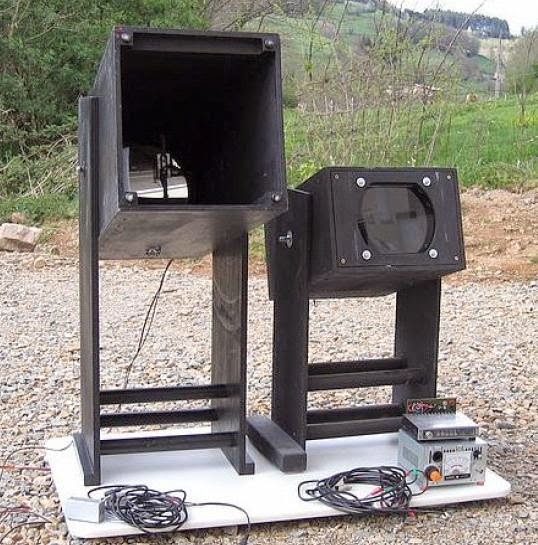 |
| F1AVY's Cloudbounce System |
"Returning to Steve's questions and our general discourse:
..is it (the RX) fairly small and portable...and lensless?
I do have a lens in the RX I now prefer to use - although it happens to be a convex lens from a tabletop magnifier - about 7x12cm giving me a narrow reception beam and a fair bit of gain compared with naked photodiode. There seems to be a general agreement that increasing the size of receiving aperture will capture more light and is the best way to greater gain.
Here I need to qualify gain requirements for my particular applications. I am currently exploring relatively short-distance NLOS paths in urban environments with abundant QRM from city and suburban lights, and this already limits my gain requirements. I developed my own qualitative test of satisfactory sensitivity - by pointing my receiver at individual stars in the sky. If I can hear them twinkle (yes they do twinkle!!!) then I am generally satisfied with the project.
On cloudy nights, pointing the RX into the clouds brings an interesting combination of mains harmonics and general hash from neon lights, clicking pulses from aeroplane lights, sweeping sounds from airport and marine lighthouses. In an environment like this, going to extreme lengths as one would do for very long-range cloudbounce or LOS comms in dark and secluded areas is simply not required and uneconomical. I initially did invest time and money in large receiving boxes with the best components there are, only to find that, unless I moved out into the bush, I could not take a real advantage of the improved performance, and did equally well with smaller and more wieldy portable designs.
"Is the idea, when talking about NLOS, to light up as much sky as possible...and that is why no focusing lenses are employed? Would a focused emitter, as produced by the typical Fresnel lens light box, produce too narrow a beam than desired? It would seem likely that with precise aiming combined with the gain to be had by utilizing fresnels (for example), would produce longer paths??"
There are several separate issues there. One is the implied requirement for a large Fresnel lens in order to obtain a narrow beam. First, how narrow is narrow enough? If we can be satisfied with say +- 5 degrees then there are more wieldy solutions available - most of the high power LEDs now have clip-on small spot lenses awailable separately - usually from third-party manufacturers. These were unheard of until recently. Standard-sized LEDs are available with very narrow radiation pattern, e.g. the SFH4550 at barely +-3 degrees. And one would expect an array of 200+ of them to behave quite like our stacked Yagis, many times over! Hence narrow beam is quite possible even without an external lens.
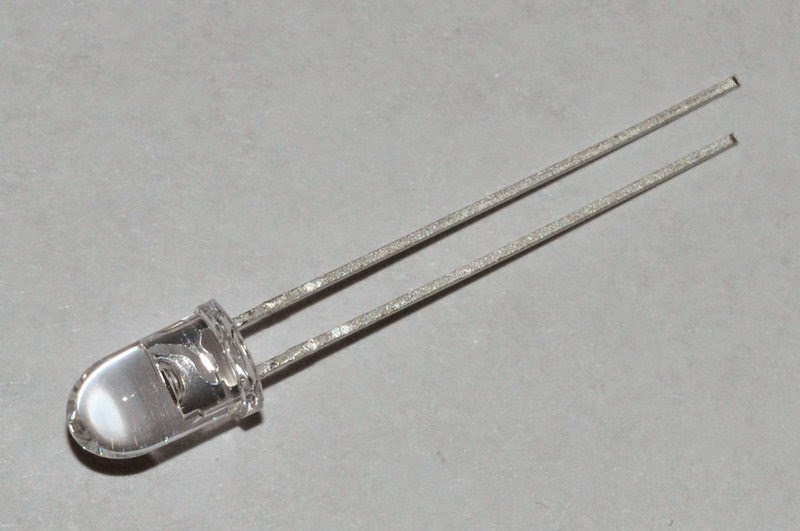 |
| Osram SFH4550 IR LED |
Of course the extremely narrow beams that one would prefer for LOS DX comms would be next to impossible to align in NLOS situation. (Invisible infrared is not a problem in LOS as it can be easily supplemented with e.g. a plain strobe light for alignment purposes.) I find my +-3 degrees array (with similar +-3 deg aperture at receiving end) hard enough to align over the horizon, and it is probably the limit of how narrow one can go to remain practicable in NLOS.
"to light up as much sky as possible..."
It is possible that cloudbounce and obstruction-bounce will develop into separate NLOS techniques, along with atmospheric scatter. Of course one can think of all of these in some topographies.
I had some success in inter-suburban cloudbounce with high beam elevations at both ends - 30 to 60 degrees. Also with 45 degrees or less elevation with TX and RX about 1km apart side by side and pointing at the same cloud in the distance. Power used around 10-20W, beamwidth +-5 to 10 degrees, red and infrared with similar results (including 950nm). The received signal was just strong enough for telegraphy or qrss, but never near enough for any type of voice modulation. Results were affected by the height of cloud cover necessitating frequent elevation adjustment, and an additional liaison channel on VHF. Signals disappeared entirely as soon as the clouds started producing rain.
I never got any usable results with clear night sky and the TX and (imaginary) RX beams crossing each other at similar elevations. Only at very close distances - the best signals being received with blue and infrared. Presumably Rayleigh scatter with blue. (This raises the possibility of usable atmospheric scatter with UV?)
Only recently I commenced preliminary tests with close-to-ground, low-elevation NLOS and immediately the infrared proved itself to be a clear winner with quite reliable and repetitive results. (Needless to say the signal strengths are marginal compared with direct LOS over similar distance.) Intuitively, one would suspect general scatter and bouncing of nearby objects being the main sources of some of the energy reaching over the horizon, with some contribution perhaps of atmospheric/dust/aerosol scatter.
This adds an additional dimension to your question.. to light up as many objects around the TX(or around RX, or around the obstruction) as possible, or send the focused beam as far as possible? I guess it will very much depend on topography. I can imagine a situation where I would prefer to use a broad floodlight rather than a focused beam - e.g. to illuminate as many as possible of the surrounding tall buildings if transmitting from a ground floor apartment. Or from the foot of a mountain. An opposite rule would apply if it is the receiver that is just behind an obstruction - here a focused TX beam and a broad RX aperture might prove advantageous. And where the main obstruction is midway between TX and TX than the usual narrow-beam configuration would apply at both ends. I think it might be worth trying an infrared TX with interchangeable lenses, and same for the RX...
The portable TRX image shows the general view. Most of the electronics is contained in a plastic box and includes an SLA battery, the RX audio bandpass filter, power amp and speaker, and most of the PWM AM TX circuitry except the final LED driver. The DIN socket provides connection to external RX front end TX output drivers and LEDs, usually held together on a tripod. The header socket is for the external microphone connection, and there are switches for power and speaker and a headphone jack. The crudely made corflute box beside it is the RX front end with lens, photodiode and preamp.

The RX detail 01 shows the business end of the photodiode, and the separate lens box (slides in and out for focus adjustment). Detail 02 shows the preamp with interchangeable photodiode modules - SFH213 for visible to 850nm, and the SFH213-FA for 850nm and below.
Multi-wavelength TX 01 (front and back image) includes several groups of fat LEDs (red, blue and 850nm) with matching lenses providing approx. +-5 degrees apertures. Also the PWM driver on 2x CAT4101 in parallel, external high current power connection, intensity control, and a PICAXE-controlled strobe or audio callsign/frequency sweep beacon.The whole assembly connects to the TRX control box (above) and can provide power to it, draw power from it, or have both DC sources in parallel.Enclosure includes a photo tripod mount on the bottom plate, and velcro strips on top to hold the RX front end.
Pocket-sized 10W IR TX is a small holiday project and still work in progress. The 7x LEDs are 2W each SFH4783 with an intrinsically narrow beam of +-10 degrees - quite appreciable for a naked LED of this size and possibly obviating the need for external optics in some applications. My usual CAT4101 drivers are included and capable of providing 2A at 50% duty cycle. Another Picaxe beacon is on the other side of the heatsink, and the voice modulator is still in progress.
The low-power multi-wavelength TX is another one day project, built to compare relative performances of 850 and 950nm IR. Three almost identical beams of red, 850 and 950 are transmitted in sequence with approx 100mA PWM running each diode. Unique CW ID has been coded for each wavelength.
6x SFH213 photodiode with individual preamps - quite a respectable low noise, high sensitivity front-end that works very well without external optics (SFH213 have a +-10 deg intrinsic apertures). A matching array of small fresnel lenses has been built and tested for narrow-beam reception, but a permanent box is yet to be added.. Some of the other gadgets seen in the foreground."
As mentioned earlier, Jan's experiments with NLOS signals utilizing IR is of particular interest to myself as I would like to continue experiments with VE7CA, on the other side of Georgia Strait...hopefully with Markus not having to move to a LOS position, but simply aiming across the Strait in a direct path, from his yard. Using Argo and QRSS3 mode, it will be interesting to see if any signals can be recovered from the cloud bottoms on some overnight runs.
More information on NLOS work may be found on the Australian Optical DX Group in Yahoo Groups as well as in the UK Nanowave Group....why is it that these two countries have so much homebrew fun??,,,and don't forget Clint's (KA7OEI) superb Optical Communications / Moduulated Light pages!
Steve McDonald, VE7SL, is a regular contributor to AmateurRadio.com and writes from British Columbia, Canada. Contact him at [email protected].






